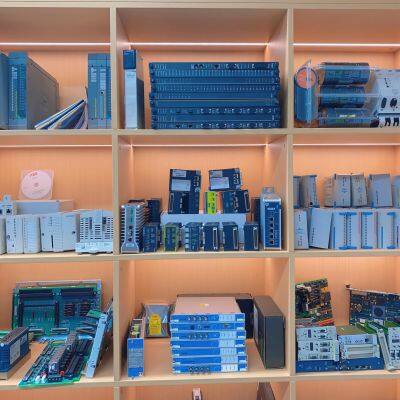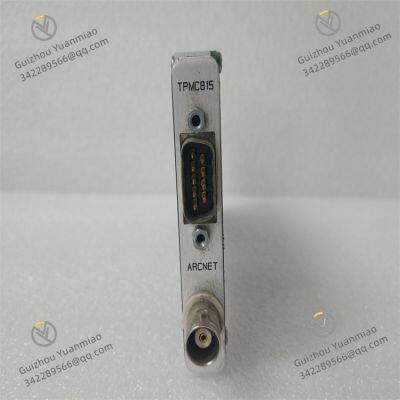Product Description
I. Overview
TEWS TPMC815-11 is a high-performance embedded multi-functional communication module based on the PCIe bus, belonging to the embedded computer product series of TEWS Technologies. It is specially designed to meet the requirements for high reliability and multi-interface communication in industrial-grade applications. Integrating rich communication interfaces and powerful processing capabilities, it can play an important role in fields such as industrial automation, aerospace, military communications, and intelligent transportation. As a core communication hub in the system, this module can realize efficient data interaction and protocol conversion between different devices and networks, providing stable and reliable hardware support for applications such as real-time monitoring and remote control in complex industrial environments.

II. Technical Parameters
Processor and Core Architecture: Equipped with a high-performance 32-bit embedded processor with a single-core architecture and a main frequency of up to 800MHz, it has efficient data processing capabilities and task execution efficiency. It can quickly handle various communication protocol conversion and data forwarding tasks, ensuring low latency and stability of data transmission.
Memory Configuration: Equipped with 512MB DDR3 SDRAM memory, providing sufficient space for program operation and real-time data caching, supporting temporary storage and fast access of large-capacity data; built-in 256MB Flash memory for storing operating systems, application programs, configuration files, etc., ensuring that data is not lost after power failure and improving system reliability.
Communication Interfaces: It has rich communication interfaces, including 2 10/100/1000Mbps Gigabit Ethernet electrical ports, supporting TCP/IP, UDP, Modbus/TCP and other protocols to achieve high-speed network communication; 4 RS-232/422/485 serial communication ports, which can be flexibly configured into different serial modes and support multiple serial protocols; 2 USB 2.0 interfaces for connecting external storage devices or debugging operations; in addition, there is 1 CAN bus interface supporting CAN 2.0A/B protocol, suitable for CAN network communication in fields such as automotive electronics and industrial control.
Bus Interface: Adopting PCIe 2.0 x1 bus interface with a data transmission rate of up to 2.5Gbps, it can realize high-speed data exchange with the host system, meet the bandwidth requirements of real-time data transmission, and ensure efficient communication between the module and the host.
Power Requirements: The operating voltage is +3.3V and +12V, with a typical power consumption of about 10W. It adopts an industrial-grade power supply design with overvoltage and overcurrent protection functions, which can work stably under power voltage fluctuations and adapt to the complex power environment of industrial sites.
Operating Environment: The operating temperature range is -40℃ to +85℃, allowing normal operation in extreme high and low temperature environments; the relative humidity is 5% - 95% (non-condensing), with good moisture resistance; the anti-vibration performance complies with MIL-STD-810G standard, with a vibration acceleration of up to 10g in the frequency range of 10 - 2000Hz; the anti-shock performance complies with MIL-STD-883H standard, with an impact acceleration of up to 50g (11ms pulse), which can withstand the vibration and impact effects of industrial sites.
Dimensions: Adopting a compact design with dimensions of 167mm × 107mm, it conforms to the PCIe card specification, can be easily installed in standard industrial computers or embedded system chassis, saving installation space.

III. Functional Features
Multi-interface Integration and Protocol Compatibility: Integrating multiple interfaces such as Ethernet, serial communication, USB, and CAN bus, it supports various mainstream industrial communication protocols including TCP/IP, Modbus, and CAN 2.0A/B. It can seamlessly connect with different types of devices and networks, realizing interconnection and intercommunication of heterogeneous networks and meeting diversified industrial communication needs.
Real-time Data Processing and Forwarding: With an 800MHz main frequency processor and efficient memory management mechanism, this module can achieve millisecond-level data processing and forwarding delay, ensuring the timely transmission of control commands and status information, and meeting the requirements for real-time data transmission in scenarios such as industrial automation control and real-time monitoring.
Industrial-grade Reliability and Stability: Using all industrial-grade components and lead-free technology, it has undergone strict environmental testing and reliability verification, with extremely strong anti-electromagnetic interference capability. It can effectively resist electromagnetic interference, voltage fluctuations and other interference factors in industrial sites, ensuring long-term stable operation of the module in harsh environments, with a Mean Time Between Failures (MTBF) of more than 80,000 hours.
Flexible Configuration and Management: It supports parameter configuration through dedicated configuration software or command-line interface. Users can flexibly set communication interface parameters, protocol types, data transmission methods, etc. according to actual application requirements; at the same time, the module has remote management functions, which can realize remote monitoring, configuration update and fault diagnosis through the network, reducing maintenance costs and difficulty.
Wide Temperature and Rugged Design: Adopting a wide temperature design, it can work stably in the extreme temperature range of -40℃ to +85℃, adapting to the harsh environments of aerospace, military and other special fields; the module shell is made of rugged metal material, with good heat dissipation performance and mechanical protection capabilities, further improving the durability and anti-environmental interference ability of the module.
Easy System Integration: As a standard PCIe module, it can be easily integrated with various industrial computers and embedded systems without complex hardware adaptation. It can work normally through simple driver installation, shortening the system development cycle and improving integration efficiency.

IV. Common Faults and Solutions
Ethernet Communication Failure
Possible Causes: Physical damage to the Ethernet interface, such as loose ports, bent or oxidized pins; poor quality, broken network cables or poor contact of crystal heads; incorrect network parameter configuration, such as IP address conflict, incorrect subnet mask or gateway settings; network switch failure.
Solutions: Check whether the Ethernet interface is physically damaged. If the port is loose, re-plug the network cable; if the pins are damaged, replace the interface or module. Replace with a qualified network cable, re-make the crystal head and ensure firm contact. Check the network parameter configuration to ensure that the IP address, subnet mask and gateway match the network environment and avoid IP address conflicts. Connect the network cable to other normal network devices for testing to check for switch faults.
Abnormal Serial Communication
Possible Causes: Damaged serial interface or incorrect wiring; mismatch between serial communication parameters (baud rate, data bits, stop bits, parity bits) and peripherals; excessive length of serial cables leading to signal attenuation; faults of the peripherals themselves.
Solutions: Check whether the serial interface wiring is correct, re-plug the cable or replace the interface; use a multimeter to check whether the interface is damaged, and replace the module if necessary. Reconfigure the serial communication parameters to ensure they are consistent with the peripheral parameters. Shorten the length of the serial cable or use a signal amplifier to enhance the signal. Connect the peripheral to other normal modules for testing to determine if it is a peripheral fault.
Module Cannot Be Recognized by the Host
Possible Causes: Poor contact of the PCIe bus interface or oxidation of the gold fingers; the module is not correctly installed in the PCIe slot; failure of the host PCIe slot; the module driver is not installed correctly or the version is incompatible.
Solutions: Turn off the host power, re-plug the module to ensure good contact of the PCIe interface; use an eraser to clean the module's gold fingers to remove the oxide layer. Check whether the module is installed in place and ensure it is fixed firmly. Insert the module into other PCIe slots of the host for testing to check for slot faults. Reinstall or upgrade the module driver to ensure compatibility with the operating system version.
Abnormal CAN Bus Communication
Possible Causes: Physical damage to the CAN interface or incorrect wiring; improper configuration of CAN bus terminal resistors; incorrect setting of CAN protocol parameters; interference in the CAN bus.
Solutions: Check whether the CAN interface wiring is correct, re-plug the cable or replace the interface; use special tools to detect whether the interface is damaged, and replace the module if necessary. Check whether the CAN bus terminal resistor meets the requirements (usually 120Ω) to ensure correct configuration of the terminal resistor. Reconfigure CAN protocol parameters, such as baud rate, to ensure consistency with other devices in the CAN network. Take anti-interference measures, such as adding a shielding layer to the CAN bus, keeping away from strong interference sources, or using a CAN bus isolator to reduce interference.
Frequent Module Crash or Restart
Possible Causes: Unstable power supply voltage or insufficient power supply; poor heat dissipation of the module, resulting in excessive operating temperature; firmware vulnerabilities or errors; internal circuit failure of the module.
Solutions: Check whether the power supply voltage is within the specified range (+3.3V and +12V), use a regulated power supply to ensure stable power supply; if the power supply is insufficient, replace with a power supply with higher power. Clean the dust on the module's heat dissipation holes and heat sinks to ensure good heat dissipation; in high-temperature environments, add cooling fans or heat sinks. Upgrade the module firmware to the latest version to fix known vulnerabilities. If the above methods are ineffective, it may be an internal circuit failure of the module, and the module needs to be replaced.


SBS VIPC616 91611524 4-slot 6U VME IndustryPack Carrier
SAT CM3141-02-03 Proximitor Seismic Monitor
SAT CM3142-01-03 Proximitor Seismic Monitor
SAT RM3141-01-02 Proximitor Seismic Monitor
RAMIX PMC008A 700502 PMC to Mezzanine Adapter
RAMIX PMC237C-008EMI Expansion Module
TeIKOOR PSMU-350-3 CPCIAC-6U-500 900-7002-10 Power Supply Module
METSO DPU-MR Processing Unit
METSO IOP302 Control Module
METSO IOP304 Control Module
METSO IOP331 Intelligent Operations Platform Module
METSO IOP345 Digital Input Module
 yezi
Hi there! Welcome to my shop. Let me know if you have any questions.
yezi
Hi there! Welcome to my shop. Let me know if you have any questions.





